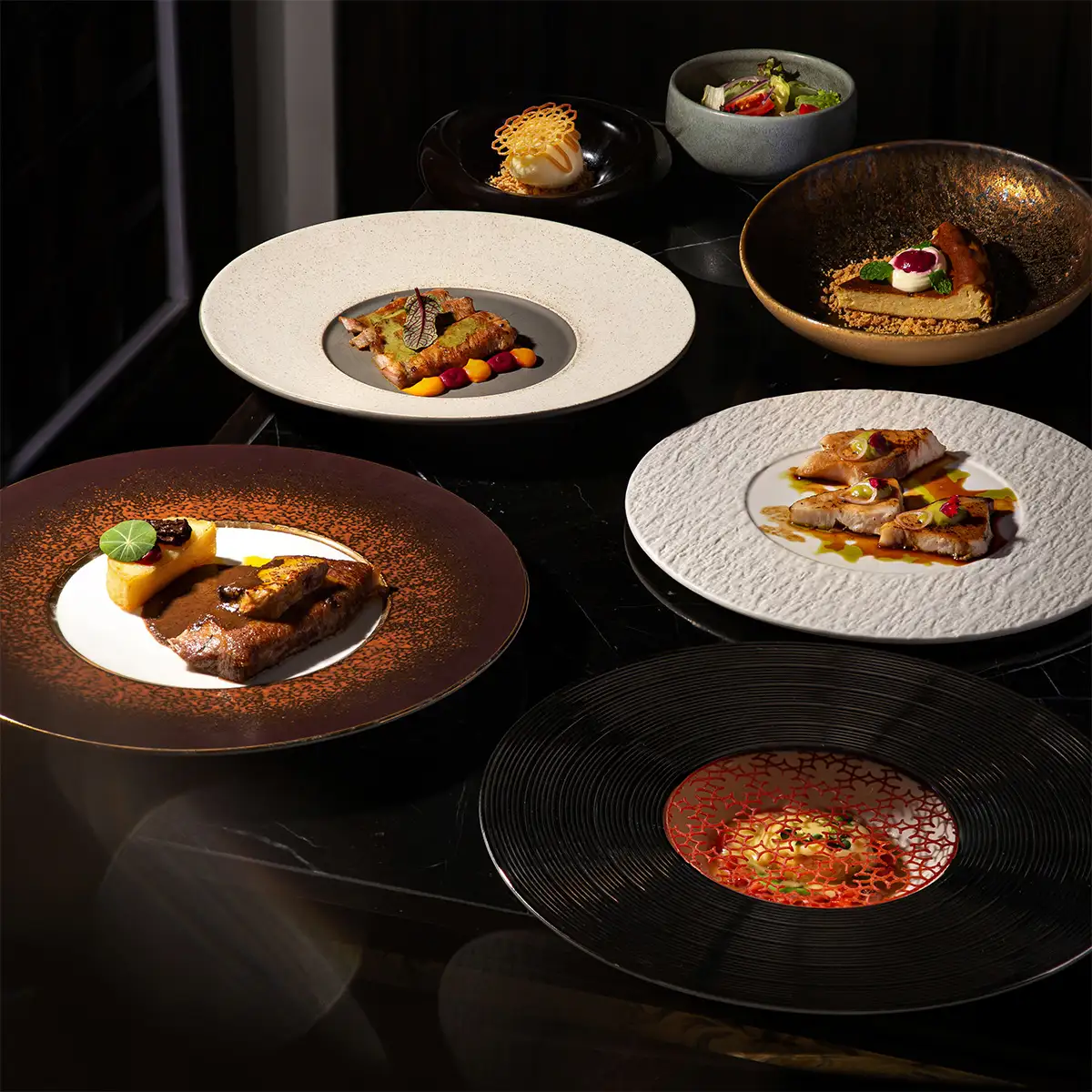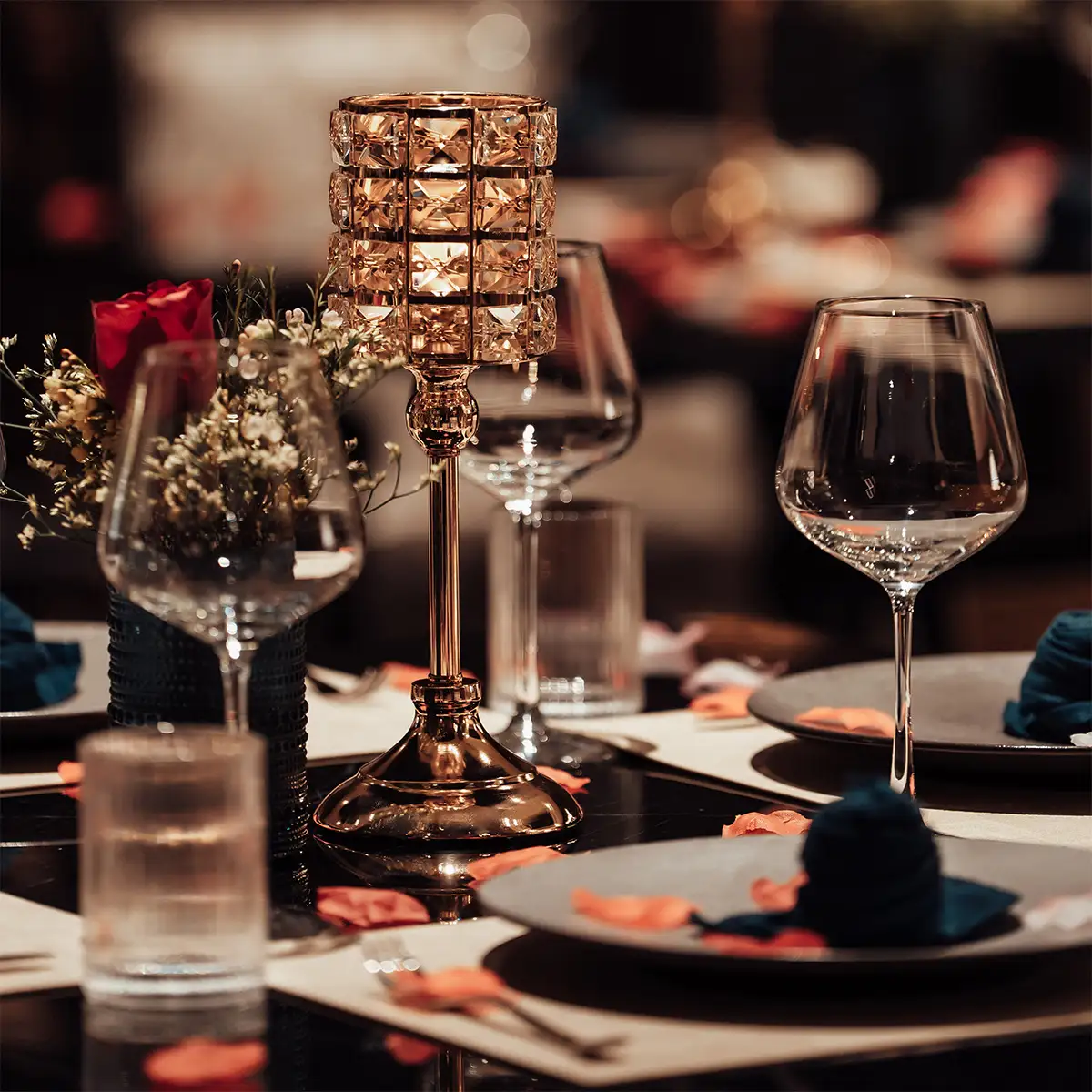The realm of high-end gastronomy extends far beyond the exquisite flavors on a plate; it encompasses an entire experience, a symphony of details where fine dining etiquette plays a pivotal role. Visiting a luxury restaurant is an opportunity to indulge not only in culinary masterpieces but also to conduct oneself with poise and confidence. This article aims to provide you with comprehensive knowledge of fine dining etiquette, ensuring every upscale dining occasion is a seamless and memorable one, and perhaps inspire you to experience this firsthand at Moca Dining.
1. What is fine dining etiquette?
Fine dining etiquette can be defined as the established set of expected behaviors, social graces, and formal dining etiquette protocols observed in luxury restaurants. These are the unwritten rules that govern conduct, ensuring a sophisticated and enjoyable atmosphere for all patrons.
Observing fine dining etiquette is crucial for several reasons:
- Enhances the dining experience: Proper etiquette contributes to a smooth, pleasant, and refined atmosphere, allowing you and your companions to fully appreciate the culinary artistry and ambiance.
- Creates a good impression on those around you: Your conduct reflects on your personal refinement and consideration for others. Adhering to fine dining table manners demonstrates respect and sophistication.
- Shows respect for the restaurant and fellow diners: Upscale establishments invest heavily in creating a particular environment. Following etiquette shows appreciation for their efforts and ensures that other guests can also enjoy their experience without disruption. For instance, maintaining a moderate speaking volume respects the intimate conversations of others.
- The difference between fine dining etiquette and basic table manners: While basic table manners (like not chewing with your mouth open) form the foundation, fine dining etiquette is more nuanced and detailed. It includes specific rules for using various types of cutlery, glassware, interacting with service staff, and navigating multi-course meals.
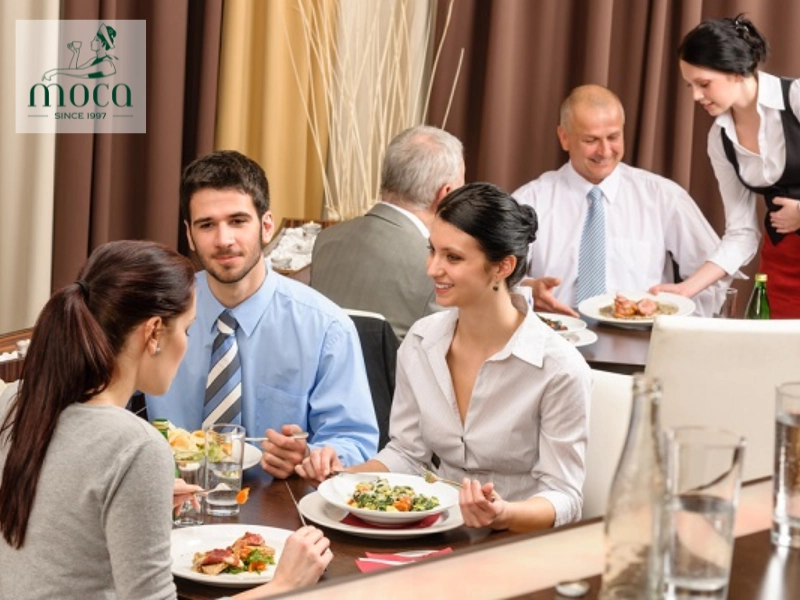
Grace in every gesture — fine dining etiquette elevates the experience
2. Preparing before arriving at the restaurant
The foundation of a successful fine dining experience is laid even before you step into the restaurant.
Make a reservation in advance:
- Why you need to book in advance: High-end restaurants, especially renowned ones like Moca Dining, often have limited seating and high demand. A reservation secures your table, prevents disappointment, and allows the restaurant to prepare for your arrival, ensuring smoother service. For popular weekend slots or special occasions, booking weeks or even months ahead might be necessary.
- How to book effectively: When booking, clearly state the number of guests, preferred date and time, and provide a contact number. If you have any special requests (e.g., a quiet table, a table with a view), mention them during the booking process, though fulfillment depends on availability.
Learn about the dress code:
- Why you need to follow the dress code: The dress code contributes significantly to the restaurant's ambiance. Adhering to it shows respect for the establishment and fellow diners. It ensures a cohesive and appropriately upscale environment.
-
Common dress codes in fine dining restaurants:
- Formal (Black Tie/White Tie): This is the most stringent, usually reserved for very exclusive events. For men, it means a tuxedo or tailcoat; for women, a floor-length evening gown.
- Semi-Formal (Business Attire/Cocktail Attire): This is common for many fine dining restaurants. For men, a suit and tie, or at least a sports jacket and smart trousers. For women, a cocktail dress, elegant separates, or a sophisticated pantsuit.
- Smart Casual (Dressy Casual): This implies a polished yet relaxed look. For men, collared shirts (polo shirts may be acceptable), chinos or smart trousers, and loafers or dress shoes. For women, a stylish dress, skirt and blouse, or smart trousers. Avoid jeans, shorts, and overly casual footwear.
- Specific examples of appropriate attire for men and women: For a semi-formal setting, a gentleman might wear a navy suit, crisp white shirt, silk tie, and polished Oxford shoes. A lady might choose a knee-length silk dress with elegant heels and subtle jewelry.
Research the restaurant:
Familiarize yourself with the restaurant's culinary style (e.g., French, Italian, Modern Vietnamese), any special menus (tasting menus, seasonal offerings), and perhaps glance at customer reviews to get a feel for the overall experience and service. This preparation can enhance your anticipation and help in making informed choices.
Notify about special requests:
If you or any of your guests have food allergies, dietary restrictions (vegetarian, vegan, gluten-free), or other important requests (e.g., celebrating a birthday discreetly), inform the restaurant when making your reservation or at least 24-48 hours in advance. This allows the kitchen to prepare and accommodate your needs effectively.
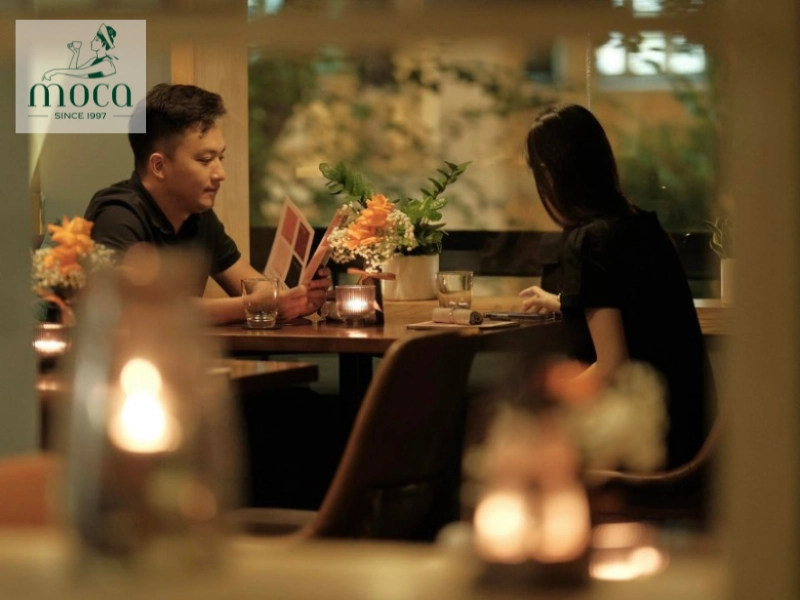
Preparation is part of the experience — elegance begins before you arrive.
Learn more: Fine Dining Attire: Your Guide to Impeccable Style
3. Behavior upon arrival at the restaurant
Your conduct from the moment you arrive sets the tone for your fine dining experience.
-
Arrive on time: Punctuality is paramount in fine dining etiquette. Arriving on time shows respect for the restaurant's schedule and for other guests who may have reservations after you. Aim to arrive a few minutes before your reserved time.
- How to handle being late: If unforeseen circumstances cause a delay, call the restaurant as soon as possible to inform them of your estimated arrival time. They may be able to hold your table, but this is not always guaranteed, especially during peak hours.
- Greetings and waiting: Upon arrival, greet the host or maître d' politely. Announce your reservation name. Allow them to guide you to your table; do not seat yourself. If your table is not immediately ready, wait patiently in the designated waiting area or bar.
-
Sitting at the table:
- How to sit properly: Approach your chair from the side indicated by the staff (often ladies are seated first, with staff sometimes assisting by pulling out the chair). Sit upright, but comfortably. Avoid slouching or leaning too far back. Purses can be placed on your lap, behind you against the back of the chair if small, or on a purse hook if provided. Never place them on the table.
- Maintain a polite attitude: Be mindful of your posture and demeanor. Engage with your companions, but keep your voice at a conversational level.

First impressions matter — grace begins at the door.
4. Rules at the table
Once seated, specific fine dining table manners come into play. These rules ensure a graceful and orderly dining process.
Using a napkin:
- How to spread the napkin on your lap: Once seated, and typically after your host or all guests are seated, unfold your napkin and place it on your lap. If it's a large napkin, you might fold it in half with the fold facing you.
- How to use a napkin to wipe your mouth: Dab or blot your lips gently. Avoid wiping vigorously.
- Where to place the napkin when leaving the table temporarily and when finishing the meal: If you need to leave the table temporarily (e.g., to use the restroom), loosely fold your napkin and place it on the seat of your chair, not on the table. When the meal is finished, place your loosely folded napkin to the left of your plate. Do not refold it precisely or crumple it.
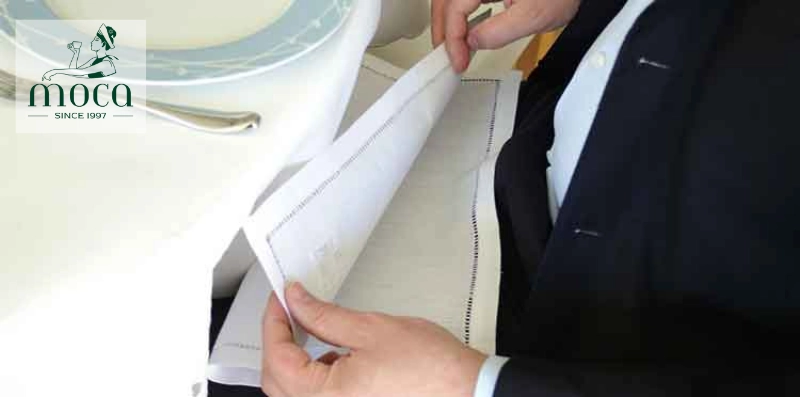
Subtle gestures, refined manners — the napkin speaks without words.
Using knives, forks, and spoons:
- The principle of using cutlery from the outside in accordance with the order of dishes: The cutlery is typically arranged in the order it will be used, starting from the outside and working your way inward with each course. The dessert spoon and fork are often placed horizontally above your plate.
-
How to hold cutlery correctly:
- Continental/European style: The fork is held in the left hand, tines pointing downwards, and the knife in the right hand. Food is speared with the fork and brought to the mouth with the tines still facing down. The knife remains in the right hand throughout.
- American style: The fork is initially held in the left hand (tines down) and the knife in the right to cut food. After cutting a piece, the knife is placed down on the upper right edge of the plate (blade facing inward), and the fork is switched to the right hand (tines up) to bring the food to the mouth.
-
How to place cutlery when pausing and when finishing a dish:
- Pausing (Continental): Place your knife and fork in an inverted "V" shape on your plate, with the tips pointing towards each other near the center of the plate. The fork tines should be down.
- Pausing (American): Rest your knife on the upper right side of your plate (blade inward) and your fork, tines up, angled towards the left.
- Finished: Place your knife and fork parallel to each other, with the handles at the 4 or 5 o'clock position and the tips (tines of the fork up, blade of the knife inward) pointing towards the 10 or 11 o'clock position. This signals to the server that you have finished.
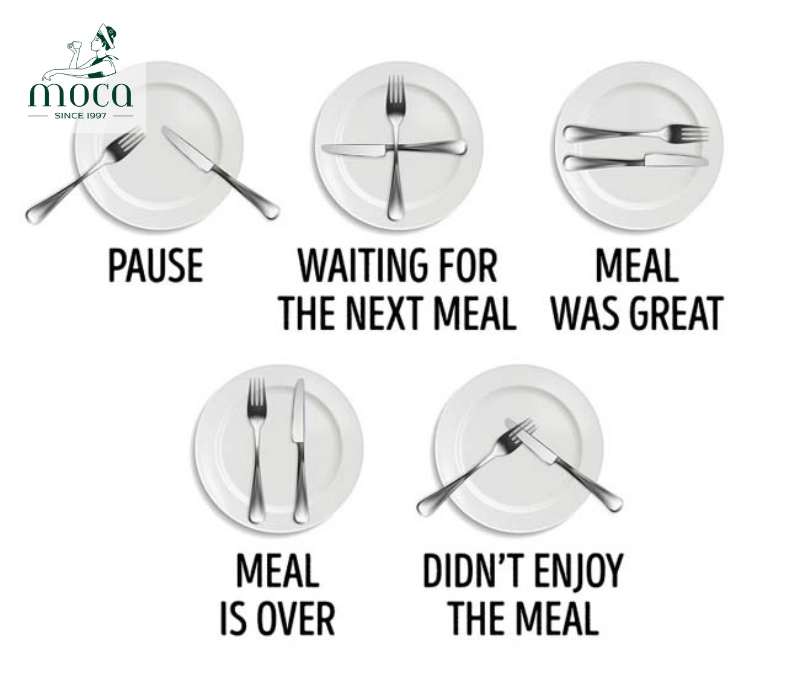
Master the language of cutlery — each placement speaks to your service
Eating politely:
- Do not talk when your mouth is full. Chew with your mouth closed.
- Eat slowly and chew thoroughly. Savor your food and the experience.
- Do not make noise while eating or drinking. Avoid slurping soup or drinks.
- Do not reach across the table. Politely ask someone to pass you a dish or condiment. "Could you please pass the salt?" is appropriate.
- Bread and Butter: Bread is typically placed on a small bread plate to your left. Break off a small piece of bread at a time with your fingers (do not cut it with a knife). Butter that one piece over your bread plate, not in the air.
Drinking water (and other beverages):
- How to hold the glass correctly: Hold a stemmed water or wine glass by the stem to avoid warming the contents with your hand and to prevent smudging the bowl. Tumblers can be held around the base.
- Do not drink too much before making a toast. Sip water or wine moderately.
- Using other items: Wine glasses will be specific to the type of wine (red, white, champagne). The bread plate is to your left, and your water glass is typically above the knife on your right.
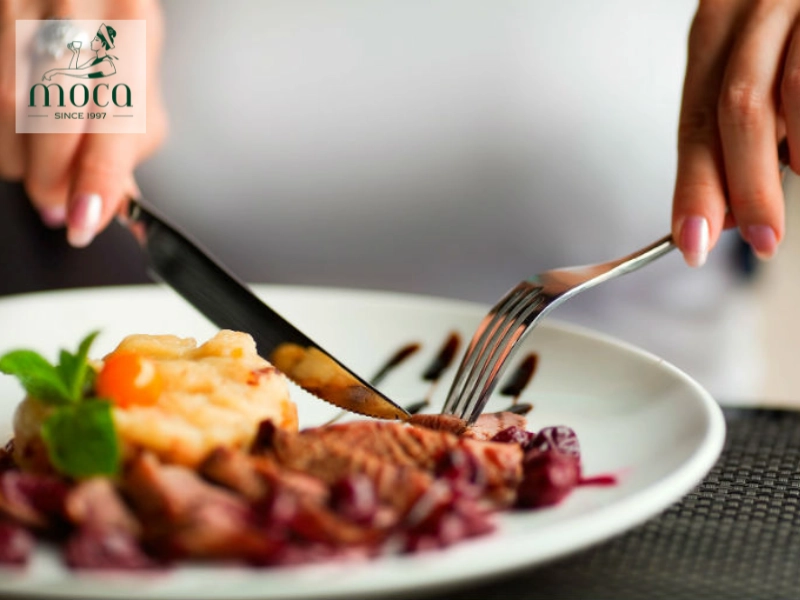
Polite dining is mindful dining — every detail reflects grace.
Learn more: Fine Dining Reservations: Your Guide to Securing the Perfect Table
5. Ordering and interacting with service staff
Courteous interaction with the service staff is a hallmark of fine dining etiquette.
-
View the menu: Take your time to peruse the menu. If you have questions about ingredients or preparation methods, feel free to ask.
- How to view the menu and choose appropriate dishes: Consider the flow of the meal if ordering à la carte (e.g., a lighter appetizer before a richer main course). Tasting menus are curated by the chef and offer a comprehensive experience.
- Ask for advice: Don't hesitate to ask the service staff (waiter/waitress or captain) for recommendations on special dishes, chef's signatures, or dishes that suit your preferences. They are knowledgeable about the menu. For instance, you could say, "I'm deciding between the sea bass and the lamb; which would you recommend this evening?"
- Order: Order politely and clearly. If there's a host, they may order for the table or indicate when guests should place their orders. Usually, ladies' orders are taken first.
-
Interact with the sommelier (if any): If the restaurant has a sommelier (wine steward), they are the expert on wine pairings.
- How to choose the right wine to pair with the dish: You can indicate your wine preferences (e.g., "a full-bodied red" or "a crisp dry white") and your budget if you wish (you can discreetly point to a price range on the wine list). Trust their expertise to suggest suitable pairings for your chosen dishes.
- Thank the service staff: A simple "thank you" when dishes are served or cleared, or when assistance is provided, is always appreciated. Show politeness and respect throughout the meal.

Politeness pairs perfectly with every course — respect enhances the dining experience.
6. Conversation at the table
Engaging conversation enhances the dining experience, but certain guidelines apply.
- Choose topics: Opt for pleasant and appropriate conversation topics. Avoid controversial subjects (e.g., divisive politics, sensitive personal issues) or anything that might make your companions uncomfortable. Good topics include travel, arts, hobbies, or shared positive experiences.
- Listen and respect: Be an active listener. Allow others to speak without interruption and show respect for differing opinions. The goal is enjoyable social interaction.
- Keep the volume moderate: Speak clearly but avoid speaking too loudly, which can disturb other diners, or too quietly, making it difficult for your companions to hear.

Meaningful moments begin with mindful conversation.
7. Payment and leaving the restaurant
Concluding your meal gracefully is as important as the preceding steps.
-
Pay the bill:
- How to pay the bill politely: When you are ready for the bill, discreetly signal your server. The bill is often presented in a folder. Review it discreetly.
- Who should pay: This depends on the arrangement. If you invited the guests, it is generally assumed you will pay. If it's a group of friends, you might agree to split the bill. Clarify this beforehand if necessary to avoid awkwardness.
- How much to tip: Tipping customs vary by country and region. In many places, a tip of 15-20% of the pre-tax bill is standard for good service in a fine dining establishment. Sometimes a service charge is already included; check the bill.
- Thank you and goodbye: As you leave, thank the service staff and the host or maître d'. If you were dining with guests, bid them a pleasant goodbye.

Graceful exits leave lasting impressions — end with elegance.
8. Introducing Moca Dining
Moca Dining is more than just a restaurant; it is a destination where culinary excellence meets sophisticated ambiance.
Located at 16 Nha Tho, Hang Trong Ward, Hoan Kiem District, Hanoi, Moca Dining offers a unique MOCA’s à la carte menu – where every dish is a perfect blend of seasonal ingredients and refined European culinary techniques. Our space is meticulously designed to provide an atmosphere of understated luxury and comfort, perfect for intimate dinners, celebratory occasions, or important business meals.
Moca Dining was born from a passion for elevating traditional flavors, creating innovative cuisine. Our journey has been one of continuous refinement, striving to offer an unparalleled dining experience.
At Moca Dining, we take pride in showcasing authentic Vietnamese flavors with contemporary techniques, artfully blending Vietnamese ingredients with international influences. This results in dishes that are both familiar and exciting, paying homage to rich culinary traditions while embracing innovation.
Our interiors are designed to be both elegant and welcoming, featuring tasteful décor, soft lighting, comfortable seating that create a perfect backdrop for a memorable meal.
Reservations at Moca Dining are highly recommended and can be made by calling us at 0819961997 or through our online reservation system at Moca Dining's Website.
Moca Dining is conveniently located at 16 Nha Tho, Hang Trong Ward, Hoan Kiem District, Hanoi. Detailed directions and a map can be found on our website.
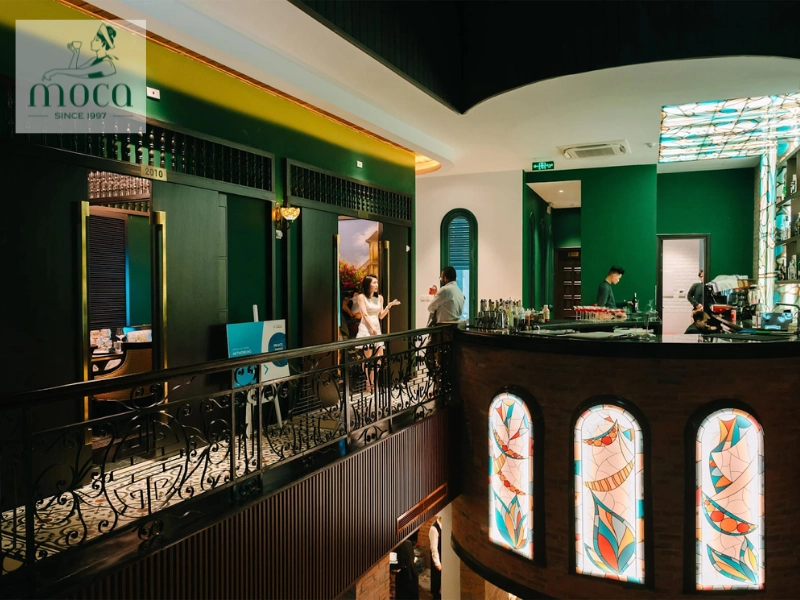
Where modern elegance meets culinary artistry — welcome to Moca Dining.
At Moca Dining, we believe that fine dining is more than just a meal—it is a sophisticated ritual where every detail matters, including your attire. Dressing appropriately not only shows respect for our establishment and fellow guests but also reflects fine dining etiquette, allowing you to fully immerse yourself in the refined elegance of the experience. Embracing fine dining attire enhances your enjoyment, elevates the ambiance, and mirrors the artistry of the culinary journey we offer. We warmly invite you to join us, dressed with intention and grace, as we create unforgettable moments together in the luxurious setting of Moca Dining.





